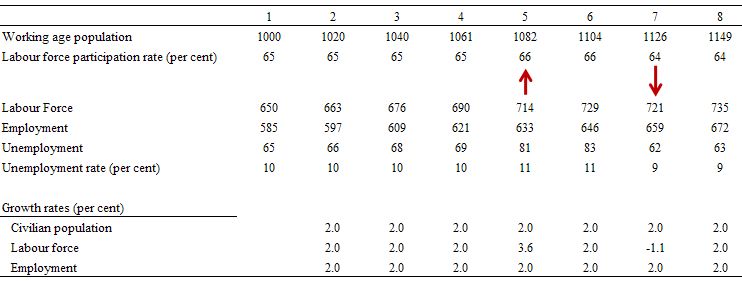
If participation rates are constant, percentage unemployment will not change as long as employment growth matches the pace of growth in the working age population (people above 15 years of age).
Answer: True
The answer is True.
The Civilian Population is shorthand for the working age population and can be defined as all people between 15 and 65 years of age or persons above 15 years of age, depending on rules governing retirement. The working age population is then decomposed within the Labour Force Framework (used to collect and disseminate labour force data) into two categories: (a) the Labour Force; and (b) Not in the Labour Force. This demarcation is based on activity principles (willingness, availability and seeking work or being in work).
The participation rate is defined as the proportion of the working age population that is in the labour force. So if the working age population was 1000 and the participation rate was 65 per cent, then the labour force would be 650 persons. So the labour force can vary for two reasons: (a) growth in the working age population - demographic trends; and (b) changes in the participation rate.
The labour force is decomposed into employment and unemployment. To be employed you typically only have to work one hour in the survey week. To be unemployed you have to affirm that you are available, willing and seeking employment if you are not working one hour or more in the survey week. Otherwise, you will be classified as not being in the labour force.
So the hidden unemployed are those who give up looking for work (they become discouraged) yet are willing and available to work. They are classified by the statistician as being not in the labour force. But if they were offered a job today they would immediately accept it and so are in no functional way different from the unemployed.
When economic growth wanes, participation rates typically fall as the hidden unemployed exit the labour force. This cyclical phenomenon acts to reduce the official unemployment rate.
So clearly, the working age population is a much larger aggregate than the labour force and, in turn, employment. Clearly if the participation rate is constant then the labour force will grow at the same rate as the civilian population. And if employment grows at that rate too then while the gap between the labour force and employment will increase in absolute terms (which means that unemployment will be rising), that gap in percentage terms will be constant (that is the unemployment rate will be constant).
The following Table simulates a simple labour market for 8 periods. You can see for the first 4 periods, that unemployment rises steadily over time but the unemployment rate is constant. During this time span employment growth is equal to the growth in the underlying working age population and the participation rate doesn't change. So the unemployment rate will be constant although more people will be unemployed.
In Period 5, the participation rate rises so that even though there is constant growth (2 per cent) in the working age population, the labour force growth rate rises to 3.6 per cent. Now unemployment jumps disproportionately because employment growth (2 per cent) is not keeping pace with the growth in new entrants to the labour force and as a consequence the unemployent rate rises to 11 per cent.
In Period 6, employment growth equals labour force growth (because the participation rate settles at the new level - 66 per cent) and the unemployment rate is constant.
In Period 7, the participation rate plunges to 64 per cent and the labour force contracts (as the higher proportion of the working age population are inactive - that is, not participating). As a consequence, unemployment falls dramatically as does the unemployment rate. But this is hardly a cause for celebration - the unemployed are now hidden by the statistician "outside the labour force".
Understanding these aggregates is very important because as we often see when Labour Force data is released by national statisticians the public debate becomes distorted by the incorrect way in which employment growth is represented in the media.
In situations where employment growth keeps pace with the underlying population but the participation rate falls then the unemployment rate will also fall. By focusing on the link between the positive employment growth and the declining unemployment there is a tendency for the uninformed reader to conclude that the economy is in good shape. The reality, of-course, is very different.
The following blog posts may be of further interest to you: